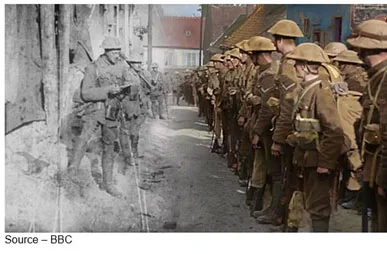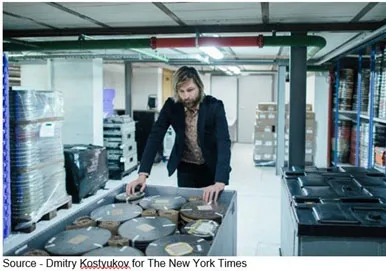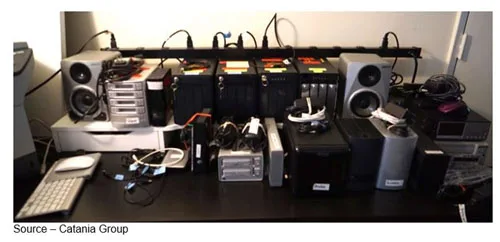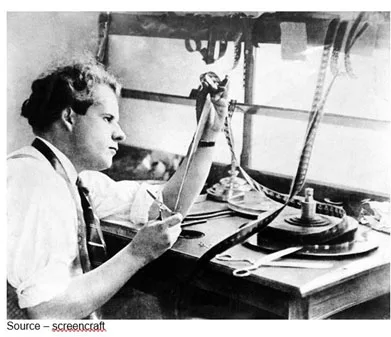It Would Be Terrible if Past Video Stories Faded Away

Periodically, it was fun to cut classes in high school–especially when there was something worthwhile showing at the town’s beat-up, run-down theater. That was the case when friends said we had to see the totally wild, chaotic film called La Dolce Vita.
During the month that followed, we went back four times trying to figure the thing out. Every time we figured we had nailed it, we’d get hit with another idea, another jolting juncture that would change or mind as to what we thought Fellini was really trying to say…gawd, we hated that!
Somewhere in a dark, temperature-controlled vault, the La Dolce Vita master print still lives; and if we’re really lucky, our kid’s kids will be able to view it and be forced to think.
We thought about the fragile state of the visual arts when WarnerMedia announced they were shutting down FilmStruck, which meant thousands of hours of independent, arthouse, foreign language and classic movies would no longer be easily available for folks to view.
The Criterion Channel will “replace” FilmStruck next spring, but the same films won’t be available.
Fortunately, they won’t disappear forever like the millions of video projects that started and ended their lives digitally. They will just go into semiretirement because they were shot/produced/stored on film; so with thoughtful storage, they’ll be around for future generations to view, enjoy!
We were lucky a few years back to meet David Wexler, founder of Hollywood Vaults, at a SMPTE (Society of Motion Picture and Television Engineers) conference where we wrangled a visit and tour of the facility.

It’s a non-descript building on a non-descript street in the LA area where people store film, tape, photographic works and yes, even digital creative works.
It is temperature controlled but it is chilling to walk through the racks and see film cannisters, hard drives, audio tapes and drawers of photos saved by relatives of long-passed writers, musicians and directors, as well as actors and other famous and not so famous people.
Fortunately, there are tens of thousands of people and groups around the globe who are determined to protect our M&E past and occasionally breath new life in the work for folks to enjoy…or learn from.
Peter Jackson gave the world an important lesson with his documentary, They Shall Not Grow Old, which was aired on BBC on Remembrance Day.

Jackson and his crew painstakingly hand-colored and 3D-digitized every frame of the film and used forensic lip-readers so actors could voice the soldiers’ words.
Gritty black and while archive footage became a brilliant documentary of our bloodied past.
Helluva’ job, Peter!
Thanks to the streaming giant Netflix, we were recently able to enjoy a film aficionados thought would never be completed, Orson Welles’ The Other Side of the Wind.
Because of constant financial problems and warring rights holders, it was called one of the most famous movies never released.
But thanks to Frank Marshall, one of the most powerful producers in Hollywood, and Netflix; they sorted through more than 100 hours of footage – 35mm, 16mm, Super 8 – to finish Welles’ collage concept with some parts in color, others in B&W.

When he fell in love with the project, Marshall wasn’t sure he had enough material to even make a film that made sense. And in typical Welles fashion, the reactions of folks who saw it at Telluride and Venice Film Festivals and most recently Netflix have been mixed.
Some viewers were befuddled and bored while others were enraptured.
For us, Welles, a polarizing filmmaker, (thanks Marshall) achieved what he wanted…he made us think.
Actually, he made us think about all of the hard creative work we’ve never had the opportunity to see because it was born digital, worked on digitally, stored digitally and accidentally or maliciously disappeared.
The industry’s move to digital has been dramatic and fantastic.
Digital cameras like Blackmagic’s URSA Mini Pro, Canon’s EOS 80D Video Creator kit and others have brought quality shooting within the reach of every serious Indie filmmaker.
Products like Blackmagic’s DaVinci Resolve – the new RAW support is killer – and Adobe’s Premiere CC have made editing, FX, colorization, audio and the entire post production process easy and economic.

There are a lot of reasons the move to digital is great for the industry– beyond being less expensive.
Digital has stimulated great advances – 4K/8K/ HDR (high dynamic range imaging), WCG (wide color gamut), Dolby Vision/Atmos, VR/AR/MR/volumetric and a growing field of audio/video technologies.
All of these advances are making video content – film, series, documentaries, shorts – fun and relatively easy to produce just at a time when video storytelling has taken center stage.
Appointment, OTT (over the top) and ad viewing on any screen, anywhere and any time has become the new norm.
Around the globe there are hundreds/thousands of new “channels” being introduced that all need content for what they hope will be an audience willing to pay for their service(s).
At the same time, setting a date to go to the theater to watch something special has held its own and thanks to a number of tentpole productions, even grown a little.
If it’s good/great, folks tell other folks and it draws an audience.
If it’s bad/pathetic, folks tell other folks and it thankfully disappears.
We sorta’, kinda’ care about all of the content effort and excitement because deep in our heart, we’re a storage guy and all of that content shooting/production needs…storage!
For all of the advances, the storage routine has remained relatively unchanged:
- Original media exactly as shot
- Protection clone (never to be touched)
- Worker copy (files renamed, organized)
- Protection copy of worker
- Studio copy of worker
- 3rd Clone of worker for safety
- Output of project
- Clone and 2nd protection
- Backup, archive
Unlike with film, today’s digital content storytellers overshoot so they have more original media to work with; and every time it moves from one production/post process to another, more stored content is produced.
By the time they’ve done a wrap on the project, they’ve racked up a total of 10x the amount of original media.
But…
Sometimes the video story doesn’t go according to script – it seldom does.
Every filmmaker, showrunner, DIT (digital imaging tech), editor and archivist has his/her horror tale.

Pixar’s Toy Story 2 has been one of the most widely discussed when the movie was being deleted before their very eyes from the servers.
When things finally stopped ,90 percent of the movie had been deleted by a stray command and the faithful tape backup…wasn’t.
Fortunately, one of the senior folks had a complete copy on her home server and after weeks of round-the-clock work, they were able to replace two months and hundreds of man-hours of work.
There are “oh s***” mishaps that occur with every digital story project – lost/bad SD (secure digital) card, hard drive that fails and content that goes poof during post – and the filmmaker simply must pull up his/her big person pants.
Usually, it’s after a couple of stiff drinks or a good cry though…sometimes both.
One Saturday, for example we received a plaintive call from a filmmaker friend that a rogue piece of code had corrupted 150TB of content in her office.

Cirina Catania, founder/creative director of The Catania Group, had years of work stored on a hodgepodge of hard drives, DAS (digital-attached storage) and RAID (random array of independent disks) that was suddenly inaccessible.
“O.K., it’s not fun but we can restore everything from your backup,” we said.
Didn’t have any!
“O.K., we’ll download copies from the cloud. It’s time-consuming and a pain but…” we commented
Didn’t have any!
Just 150TB of shots and memories sitting there just beyond her reach.
Most of her projects couldn’t be reshot, even if she could afford the time and money to reshoot.
Gawd, we were hurting.
The semi-good news was that after hundreds of hours of painstaking work, friends at SoftRAID and DriveSavers were able to recover 80 percent of the data but none of the metadata.
That meant the content was there, but she didn’t know which data without the data about the data, so she had to open every file, view/review it, and tag it/store it so she could find the pieces she needed to work with.
Major and minor disasters like these will be experienced every; year and even when they’re completed and stored away on SSDs (solid state drives) and hard drives, they can disappear because the storage device will ultimately fail.
That’s why paranoid filmmakers we know backup everything and then back it up a couple of more times and perhaps store it in someone’s cloud somewhere and hope no one steals or corrupts it “up there.”

As old-fashioned as it is, film is still the best archival solution available for finished projects or tons of reels that need to be painstakingly viewed/reviewed to finish unbelievable works like They Will Not Grow Old, The Other Side of the Wind, as well as long/short content we don’t even know but would probably really enjoy.
Fortunately, there are national, regional, state, local and even personal film archives around the globe that want to save films and digital stories for tomorrow.
The International Federation of Film Archives focuses on preserving and giving access to our film and video heritage.
The world of streaming could step in and fill the void left by WarnerMedia shutting down FilmStruck but for the shortsighted (greedy) roadblocks of licensing restrictions, rights holders and cynical commercial concerns of folks.
While they might cover their costs or even make a little money by offering a rich library of classic, arthouse, niche films, shows and long forgotten stories, folks like Netflix, Amazon Prime, Disney +, Sky, Tencent, YouTube and others find it much easier and more financially rewarding to avoid the hassle.
Just at a time when there are so many ways people can enjoy and learn from the amazing creative work of the past, it could fade before our eyes.
 Or, maybe the streamers can pool their legal and creative production talent.
Or, maybe the streamers can pool their legal and creative production talent.
It would really be great if Binyon’s words could ring true…
They shall grow not old, as we that are left grow old:
Age shall not weary them, nor the years condemn.
At the going down of the sun and in the morning,
We will remember them.
There are a lot of visual stories we’d like to enjoy with our kids and for them to enjoy with their kids and…
# # #